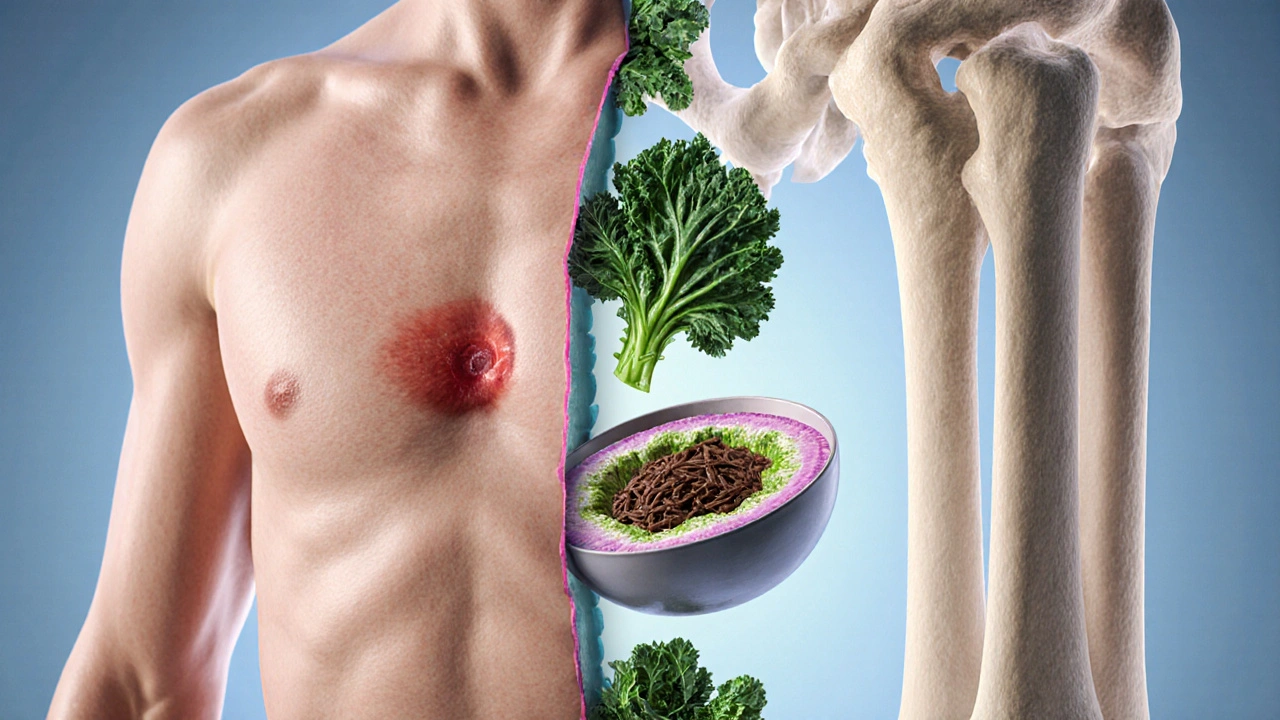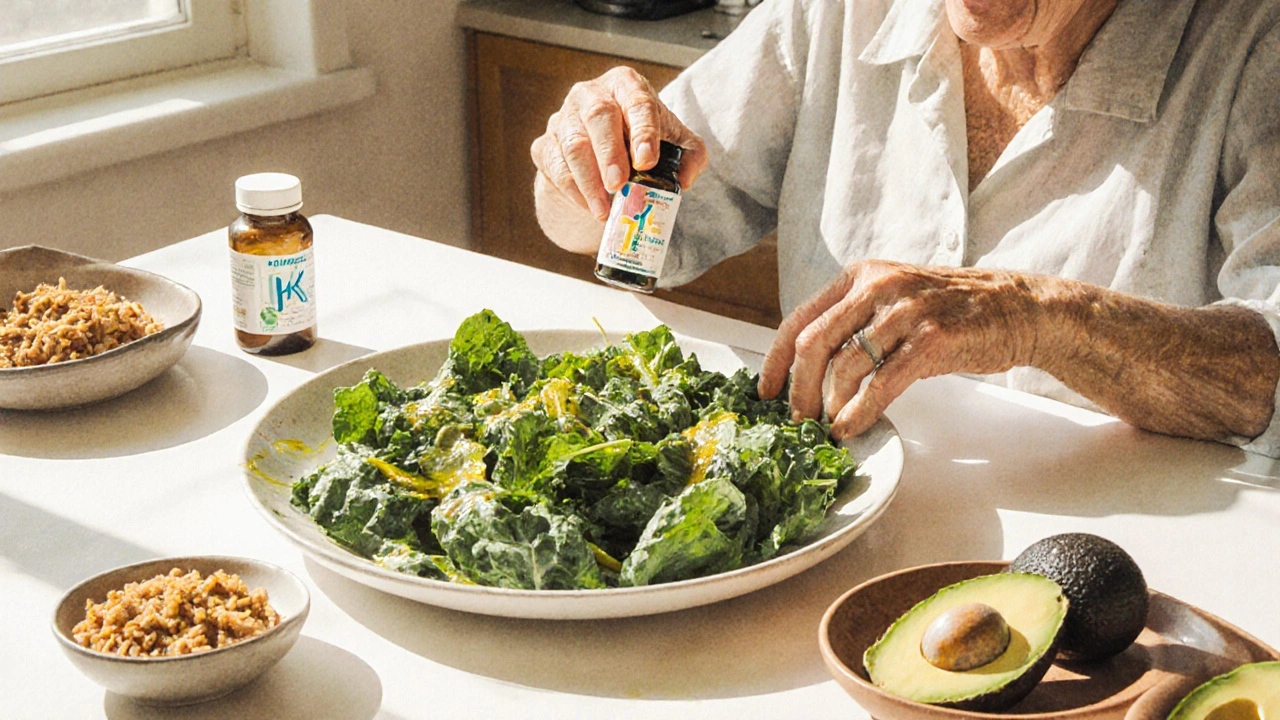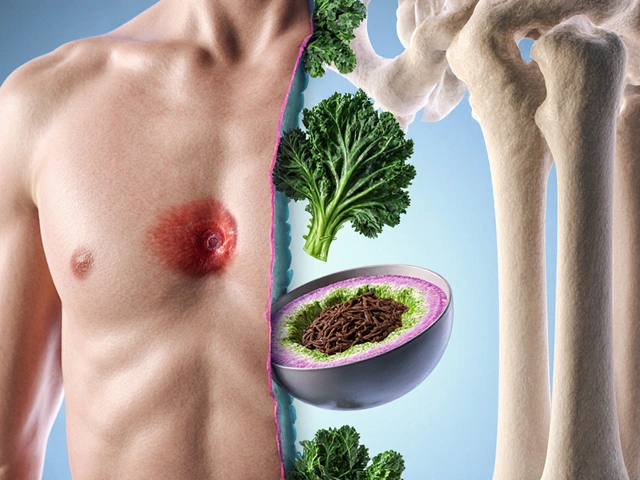Consequences of Vitamin K Deficiency on Blood Clotting and Bone Health

Vitamin K Intake Calculator
Daily Vitamin K Intake Calculator
Estimate your vitamin K intake from foods and supplements to understand how it affects blood clotting and bone health.
How Vitamin K Affects Your Health
Blood Clotting Impact
Estimated effect on blood clotting time...
Bone Health Impact
Estimated effect on bone mineral density...
Daily Requirements
- K1 Adults: 90-120 mcg/day
- K2 Adults: 90-180 mcg/day
- Risk Groups Newborns, warfarin users, malabsorption conditions
- Ideal 100-200 mcg K1 + 45-100 mcg K2 daily
Lab Test Reference
PT: 0 sec (Normal: 11-13.5)
INR: 0 (Normal: 0.8-1.2)
BMD: 0 (Normal: >-1.0)
When your body doesn’t get enough vitamin K deficiency, the ripple effects hit two vital systems: blood clotting and bone health. Vitamin K deficiency may sound obscure, but its impact can be life‑changing.
Key Takeaways
- Vitamin K is essential for clotting factors II, VII, IX, and X; without it, bleeding time increases dramatically.
- In bone, vitamin K activates osteocalcin, a protein that binds calcium to the matrix.
- Deficiency shows up as easy bruising, nosebleeds, prolonged PT/INR, and loss of bone density.
- Newborns, people with malabsorption, liver disease, and those on long‑term warfarin are highest risk.
- Boosting intake through leafy greens, fermented foods, or a calibrated supplement reverses most symptoms.
What Is Vitamin K?
Vitamin K is a fat‑soluble vitamin that exists mainly in two forms: K1 (phylloquinone) found in green leafy vegetables, and K2 (menaquinone) produced by gut bacteria and present in fermented foods like natto. Both forms feed the same biochemical pathway - the carboxylation of specific proteins that need a calcium link to work.
How Vitamin K Powers Blood Clotting
When a blood vessel is damaged, the body launches the coagulation cascade. Four key clotting factors - prothrombin (Factor II), Factor VII, Factor IX, and Factor X - need a carboxyl group added to become functional. Vitamin K acts as a co‑factor for the enzyme gamma‑glutamyl carboxylase, which performs this modification. Without enough vitamin K, these proteins stay inactive, the clot takes longer to form, and you end up with prolonged bleeding.
Vitamin K’s Role in Bone Health
The bone matrix contains a protein called osteocalcin. Like clotting factors, osteocalcin must be carboxylated to bind calcium crystals. Vitamin K enables this step, turning osteocalcin into a calcium‑attracting nail that strengthens bone. Research from 2023 shows that people with higher dietary vitamin K intake have up to 15% higher bone mineral density (BMD) than those with low intake.
Bleeding Problems When Vitamin K Is Low
Clinical signs of a clotting deficit are easy to spot:
- Frequent bruising from minor bumps.
- Nosebleeds that last longer than a few minutes.
- Excessive bleeding after dental work or minor cuts.
- Elevated prothrombin time (PT) and International Normalized Ratio (INR) on lab tests.
For example, a 2022 cohort of 1,200 patients on chronic anticoagulation showed that those with sub‑therapeutic vitamin K levels had PT values 3-4 seconds above normal, translating to a 2‑fold rise in spontaneous bleeding events.
Bone Damage From Prolonged Deficiency
When osteocalcin stays under‑carboxylated, calcium leaks from the matrix, leading to:
- Lower bone mineral density measured by DXA scans.
- Higher risk of vertebral compression fractures, especially in post‑menopausal women.
- Slower fracture healing - studies in rats showed a 30% slower callus formation when vitamin K was removed from the diet.
In a 2024 longitudinal study of 5,000 adults over 10 years, those with dietary vitamin K intake below 50µg/day had a 22% higher incidence of osteoporotic fractures compared with those consuming more than 150µg/day.
Who Is Most Likely to Develop a Deficiency?
Risk groups include:
- Newborns - they have low hepatic stores and rely on gut flora, which isn't fully established.
- People with fat‑malabsorption syndromes - conditions like celiac disease, Crohn’s disease, or pancreatic insufficiency limit vitamin K absorption.
- Liver disease patients - the liver produces the clotting factors that need vitamin K.
- Long‑term users of warfarin or other vitamin K antagonists.
- Those on broad‑spectrum antibiotics - they wipe out gut bacteria that synthesize K2.
Detecting Vitamin K Deficiency
The most reliable lab markers are:
- Prolonged PT/INR - a direct read‑out of clotting efficiency.
- Under‑carboxylated osteocalcin (ucOC) levels - a specific bone‑health indicator.
Clinicians also ask about daily diet: rarely eating leafy greens or fermented foods is a red flag.

Prevention and Treatment Strategies
Dietary tweaks often solve the problem:
- Leafy greens - kale, spinach, and collard greens deliver 100-200µg of K1 per cup.
- Fermented foods - natto provides up to 1,000µg of K2 per serving.
- Healthy fats - vitamin K is fat‑soluble, so pair greens with olive oil or avocado.
If diet isn’t enough, a supplement of 100µg of K1 or 45µg of K2 daily can normalize PT within 3-5 days and reduce ucOC levels in 2‑4 weeks. Always coordinate with a healthcare provider, especially when on warfarin, because sudden vitamin K spikes can destabilize anticoagulation.
Quick Comparison: Normal vs. Deficient Values
| Marker | Normal Range | Deficiency Range | Typical Symptom |
|---|---|---|---|
| Prothrombin Time (PT) | 11-13.5seconds | >15seconds | Prolonged bleeding |
| INR | 0.8-1.2 | >1.5 | Easy bruising, nosebleeds |
| Under‑carboxylated Osteocalcin (ucOC) | <40ng/mL | >80ng/mL | Decreased BMD, fracture risk |
| Bone Mineral Density (T‑score) | >‑1.0 | <‑2.5 | Osteoporosis |
Practical Tips to Keep Vitamin K Levels in Check
- Include at least one serving of dark leafy greens in daily meals.
- Add a teaspoon of olive oil or a few slices of avocado to boost absorption.
- If you’re on antibiotics, consider a probiotic that contains K2‑producing strains.
- Ask your doctor for a PT/INR check if you notice unexplained bruising.
- For bone‑health concerns, combine vitamin K intake with calcium and vitamin D.
Frequently Asked Questions
Can I get enough vitamin K from food alone?
Yes. A single cup of cooked kale (about 625µg K1) exceeds the daily adequate intake for most adults. Pairing it with a healthy fat helps absorption, so a drizzle of olive oil makes a big difference.
What’s the difference between K1 and K2 for bone health?
K1 mainly supports liver‑based clotting, while K2 (especially MK‑7) circulates longer and is more efficient at carboxylating osteocalcin in bone tissue. Including both sources gives the most comprehensive benefit.
Should I stop taking warfarin if I’m low on vitamin K?
Never stop warfarin without medical advice. Instead, work with your provider to adjust the dose or introduce a consistent, modest amount of vitamin K in the diet to stabilize INR readings.
How quickly can supplements correct a clotting issue?
Oral vitamin K1 (10mg) can normalize PT within 6‑12hours in most adults. For chronic deficiency, a daily dose of 100µg for 2‑3 weeks is usually enough to bring labs back to normal.
Is vitamin K deficiency common in older adults?
Yes. Age‑related changes in gut microbiota and reduced dietary intake raise the risk. Screening with PT/INR and ucOC is recommended for anyone over 65 who has unexplained bruising or low bone density.




Vitamin K deficiency is frequently dismissed as a marginal concern, yet the clinical evidence disproves such complacency.
The coagulation cascade depends on the gamma‑carboxylation of factors II, VII, IX, and X, a reaction that is unequivocally vitamin K‑dependent.
When dietary intake falls below the recommended threshold, the resulting hypocarboxylation prolongs prothrombin time and inflates INR values.
This biochemical derangement translates clinically into prolonged bleeding after minor trauma, persistent epistaxis, and excessive bruising.
Simultaneously, the skeletal system suffers because osteocalcin remains under‑carboxylated and cannot effectively bind calcium within the bone matrix.
Numerous epidemiological studies have linked sub‑optimal vitamin K status with decreased bone mineral density and heightened fracture risk, especially in post‑menopausal women.
Newborns illustrate the urgency of the issue; without adequate hepatic stores and a mature gut microbiome, they are prone to hemorrhagic disease of the newborn.
Patients with malabsorptive disorders such as celiac disease, Crohn’s disease, or chronic pancreatitis exhibit markedly lower serum phylloquinone concentrations.
Chronic warfarin therapy further compounds the problem by antagonizing vitamin K recycling, demanding vigilant monitoring of PT/INR.
The therapeutic response to dietary correction is robust; a modest increase of 150 µg of K1 per day can normalize clotting times within a week.
Fermented foods rich in menaquinone, particularly natto, supply up to 1 000 µg per serving and accelerate the carboxylation of osteocalcin.
Supplementation with 100 µg of K1 or 45 µg of K2, when administered under medical supervision, consistently reduces under‑carboxylated osteocalcin levels in two to four weeks.
Ignoring these interventions is negligent, especially for high‑risk groups who already harbor compromised hemostasis.
Clinicians should therefore incorporate a vitamin K assessment into routine blood panels for patients on anticoagulants or with bone‑loss concerns.
Patient education must emphasize that vitamin K is fat‑soluble; coupling leafy greens with a source of dietary fat maximizes absorption.
In sum, the dual jeopardy of impaired clotting and skeletal fragility mandates proactive nutritional strategies rather than passive acceptance of deficiency.
Great overview, very helpful for anyone looking to improve their diet.
Vitamin K’s role stretches far beyond the basic textbook definition, touching both hemostasis and skeletal integrity.
For newcomers to nutrition science, the concept of carboxylation can seem intimidating, but it simply means “activating” proteins that bind calcium.
Incorporating a variety of leafy greens, such as kale and collard greens, ensures a steady supply of K1 throughout the week.
Adding fermented staples like natto or aged cheeses introduces K2, which works synergistically with K1.
Remember that vitamin K is fat‑soluble, so a drizzle of olive oil or a handful of nuts can dramatically improve its bioavailability.
Consistent intake, rather than occasional large doses, is the key to maintaining healthy clotting times and bone density.
The manuscript presents a comprehensive overview of vitamin K metabolism, yet it neglects to quantify the bioavailability differences between phylloquinone and menaquinone.
A rigorous comparative analysis of plasma K1 versus K2 concentrations post‑ingestion would have strengthened the conclusions.
Moreover, the statistical methodology employed to correlate dietary intake with PT/INR values appears underpowered, given the modest sample size referenced.
The discussion on warfarin interactions, while pertinent, fails to address the mechanistic implications of chronic vitamin K antagonism on hepatic synthesis pathways.
In future iterations, inclusion of a multivariate regression model is advisable to isolate confounding variables.
I totally get how overwhelming it can feel when you hear about vitamin K deficiency and all the medical jargon.
The good news is that simple dietary tweaks can make a huge difference in clotting and bone health.
Adding a couple of cups of spinach or a serving of natto each week is often enough to bring levels back to normal.
If you’re on warfarin, definitely talk to your doctor before making any big changes – they can help you adjust the dose safely.
Remember, you’re not alone in this journey, and many patients have definently improved after following these guidelines.
Ah, the oft‑overlooked aristocrat of micronutrients, vitamin K, struts onto the stage of physiological grandeur with unrivaled poise.
Its magisterial command over the γ‑carboxylation of clotting factors bestows upon the circulatory system a regal shield against hemorrhagic chaos.
Simultaneously, it orchestrates the osteogenic ballet, coaxing osteocalcin to embrace calcium in a pas de deux of skeletal fortitude.
One must not underestimate the culinary alchemy required; a verdant cavalcade of kale, spinach, and collard greens, paired with the umami opulence of natto, conjures the perfect symphony.
Neglecting this noble vitamin is tantamount to inviting a silent coup d’état within our own marrow and vasculature.
Thus, let us raise our forks in reverence to the verdant savior that is vitamin K.
Look, if you’re not getting enough leafy greens you’re basically asking for trouble.
Blood won’t clot right and your bones will feel the pain later on, plain and simple.
I’ve seen people brush it off, saying “oh it’s just a little bruise,” but that’s a lazy excuse.
Start adding a cup of kale or a spoonful of natto to your meals, and don’t forget to throw in some healthy fat so your body actually absorbs the K.
Trust me, the change shows up in the mirror and the doctor’s report – you’ll notice fewer bruises and stronger joints.
So stop messing around and get your vitamin K on point.
The pharmacokinetic profile of phylloquinone indicates a rapid intestinal absorption phase followed by hepatic sequestration.
Conversely, menaquinones exhibit a prolonged half‑life attributable to their lipophilic nature and microbial synthesis in the distal gut.
Clinicians should therefore consider the differential bioavailability when prescribing supplementation regimens.
From a pathophysiological perspective, under‑carboxylated osteocalcin serves as a reliable biomarker for skeletal insufficiency.
Integrating these parameters into a comprehensive management algorithm can optimize patient outcomes.
Vitamin K is the unsung hero of clotting and bone health.
Eat greens and fermented foods keep levels steady.
Supplement modestly if diet falls short.
Watch PT INR numbers for clues.
Strong bones start with proper calcium binding.